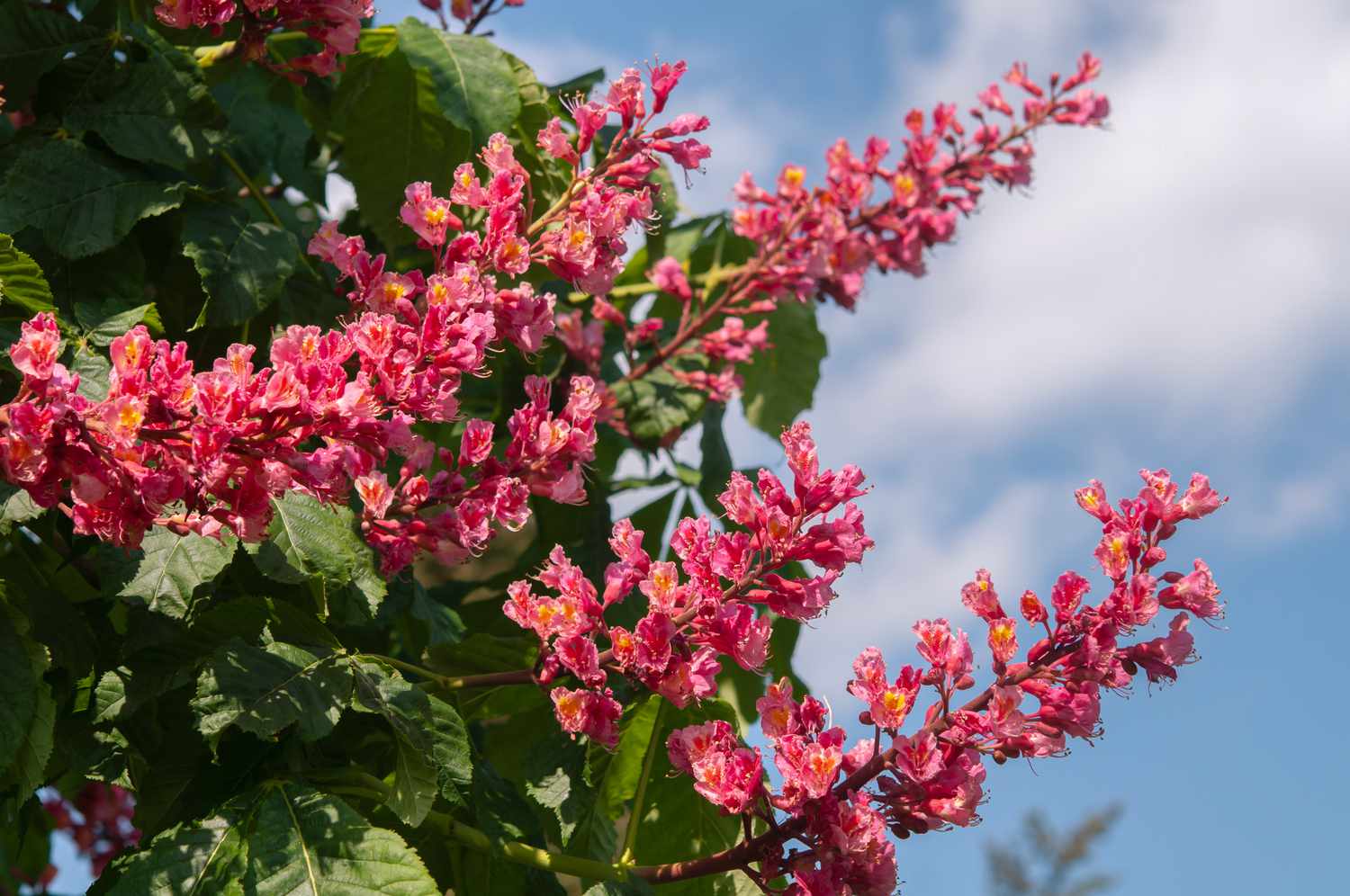In order to attract hummingbirds, it is crucial to find flowers that can withstand and thrive in your specific weather conditions. If the temperatures are either too hot or too cold, the plants may either perish or fail to produce enough flowers to provide nectar for the hummingbirds.
To determine suitable plant options, the USDA plant hardiness zone map divides the United States into 13 different zones based on the average minimum temperature. Additionally, within each state, there may be different zones. Plants can flourish in different zones, tolerating minimum temperatures, but they may not survive if the conditions become excessively cold.
For the majority of Maryland, the plant hardiness zones are 6 and 7, except for a small region in the west classified as zone 5, and another small area in the southeast designated as zone 7.
It is worth noting that certain plants can also struggle with excessively high temperatures. To address this concern, the American Horticultural Society has created the plant heat-zone map, which illustrates the average number of days in an area with temperatures exceeding 86 degrees Fahrenheit.
Regarding Maryland, it falls within heat zone 2 to 5. As a result, the colder winters pose more challenges to some hummingbird plants compared to the heat.
To ensure the selection of appropriate plants that offer nectar-rich flowers adored by hummingbirds and can thrive in Maryland’s weather conditions, all the listed plants have been cross-checked against the cold and heat zones in the state.
It is important to note that plants listed for cold zone 7 or 8 may struggle to survive the colder winters in zones 5 or 6 in Maryland without protective measures.
To attract hummingbirds in Maryland, it is recommended to plant as many of these flowers as possible.
Hummingbird Plants Suitable for Maryland’s Hardiness Zones 5 and 6:
1. Nasturtiums
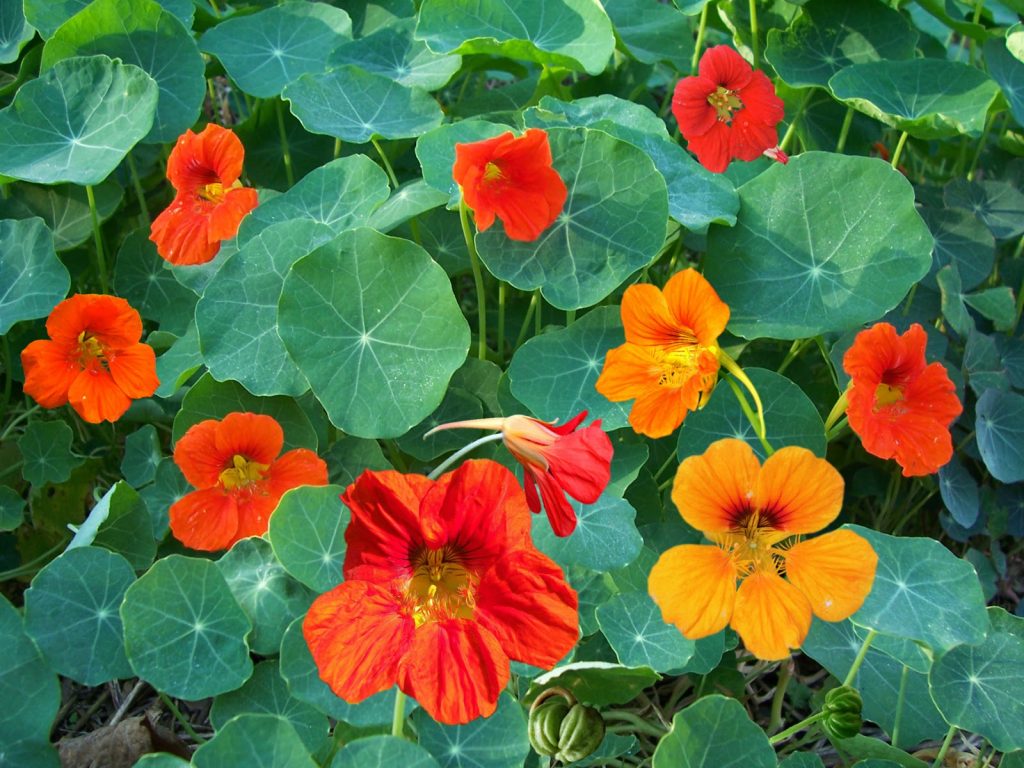
Nasturtiums are cascading edible flowers that are perfect for creating hanging baskets to entice hummingbirds due to their abundant nectar and uniquely designed deep blossoms.
Typically cultivated as annuals, they come in trailing or bush varieties. Plant the seeds immediately after the last frosts outdoors and ensure they receive adequate watering during the growing season. Deadheading is also necessary.
Common Name: Nasturtiums
Scientific Name: Tropaeolum
Growing Zones: 2 – 11
Sun: Full sun
Soil: Well-drained
Colors: Red, orange, yellow, pink
Height: 1 – 10 feet
Spread: 1 – 3 feet
Plant Type: Annual
2. Zinnia
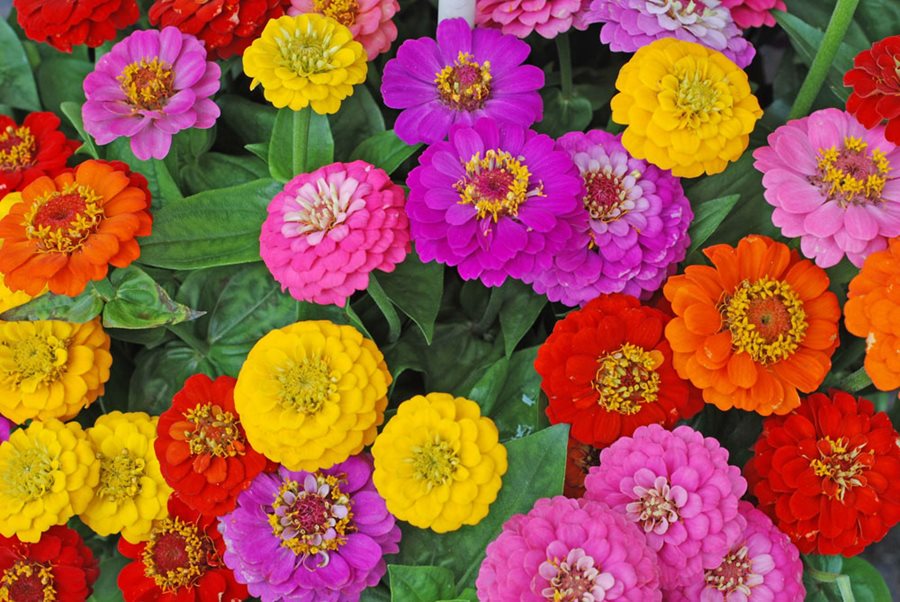
Zinnias are flowering shrubs native to North America’s scrublands and dry grasslands. They belong to the sunflower tribe, Heliantheae, within the larger Asteraceae family.
Zinnias can be classified into three main types based on their petal structure. Single-flowered zinnias have a single row of petals with a visible center, while double-flowered zinnias possess numerous rows of petals without a visible center. Semi-double-flowered zinnias also have multiple rows and visible centers.
Zinnia elegans, with its tall stems and vibrant colors, is considered a classic choice and is highly popular in backyards and gardens. Reaching a height of 4 feet, it boasts numerous brilliantly colored flowers and offers a long blooming period from early summer until frost. These flowers attract pollinators like butterflies and hummingbirds.
Growing zinnias is relatively simple, but they should be planted directly where they are intended to grow, as they do not tolerate transplantation well. Once established in an area with full sun and well-draining soil, they will provide bright blooms for an extended period.
Common Name: Zinnia
Scientific Name: Zinnia elegans
Growing Zones: Annuals in 2-8, Perennials in 9-11
Sun: Full sun
Soil: Neutral to slightly alkaline, well-draining
Colors: White, yellow, orange, pink, red, purple
Height: 1 – 4 feet tall
Spread: 12 – 18 feet wide
Plant Type: Annual, perennial shrubs
3. Agastache
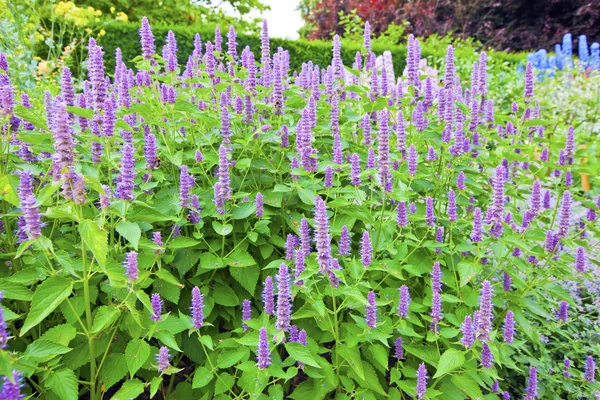
Agastache, pronounced as “ah-GAH-stuh-kee,” encompasses aromatic herbaceous perennials, with approximately 22 species, most of which are native to North America. They are commonly referred to as “hummingbird mints” and “Giant hyssops.” In addition to attracting hummingbirds, they can be used to make herbal tea.
Agastache flowers capture hummingbirds’ attention due to their distinctive appearance among the foliage. These flowers, which grow in clusters, are approximately 3 to 4 inches long and possess a fuzzy texture. The vibrant purple and red colors are particularly appealing to hummingbirds, especially when the flowers are in full bloom during the summer.
To cultivate Agastache flowers, it is best to start them as indoor plants in May and then transplant them into flower beds during the summer. They require full sun and regular watering during the establishment phase. However, once established, they exhibit drought tolerance and can thrive with minimal intervention.
Since Agastache plants are native to desert regions, they can withstand extremely hot days. Once established, excessive watering can cause root rot, so it is advisable to water them sparingly and allow the soil to dry out between waterings.
Common Name: Agastache, Hummingbird Mint, Hyssop
Scientific Name: Agastache
Growing Zones: 3 – 10
Sun: Full sun
Soil: Lean, well-draining
Colors: Blue, purple, red, orange, pink, white
Height: 3 to 5 feet tall
Spread: Varies
Plant Type: Herbaceous perennial
4. Morning Glory

The term “Morning Glory” encompasses over 1,000 species of flowering plants from the Convolvulaceae family. These plants are named “Morning Glory” because their flowers unfurl early in the morning and close during the heat of the day. However, some species within the Morning Glory family bloom at night instead, such as Ipomoea alba.
Morning Glory flowers are characterized by their vibrant colors, rapid vine growth, bright green foliage, and tolerance for poor and dry soils. They are often trained to climb arbors or allowed to creep along the exterior walls of houses using trellises.
One popular Morning Glory species known for attracting hummingbirds is Ipomoea purpurea. It boasts bright purple, trumpet-shaped flowers and heart-shaped leaves that open in the morning and close in the afternoon. These flowers bloom from early summer until early fall.
While Morning Glory is an annual vine, it may exhibit perennial traits in milder climates. It is important to provide Morning Glories with full sun exposure, ideally around 8 hours of sunlight each day, to encourage optimal blooming.
As Morning Glories tend to grow rapidly, they can become invasive if not properly managed. Additionally, their seeds are toxic if consumed, so it is essential to keep them away from children and pets.
Common Name: Morning Glory, common morning glory
Scientific Name: Convolvulaceae family
Growing Zones: 2 – 11
Sun: Full sun
Soil: Moist, well-draining
Colors: White, pink, purple, blue
Height: 6 – 10 feet tall
Spread: 3 – 6 feet wide
Plant Type: Annual
5. Impatiens
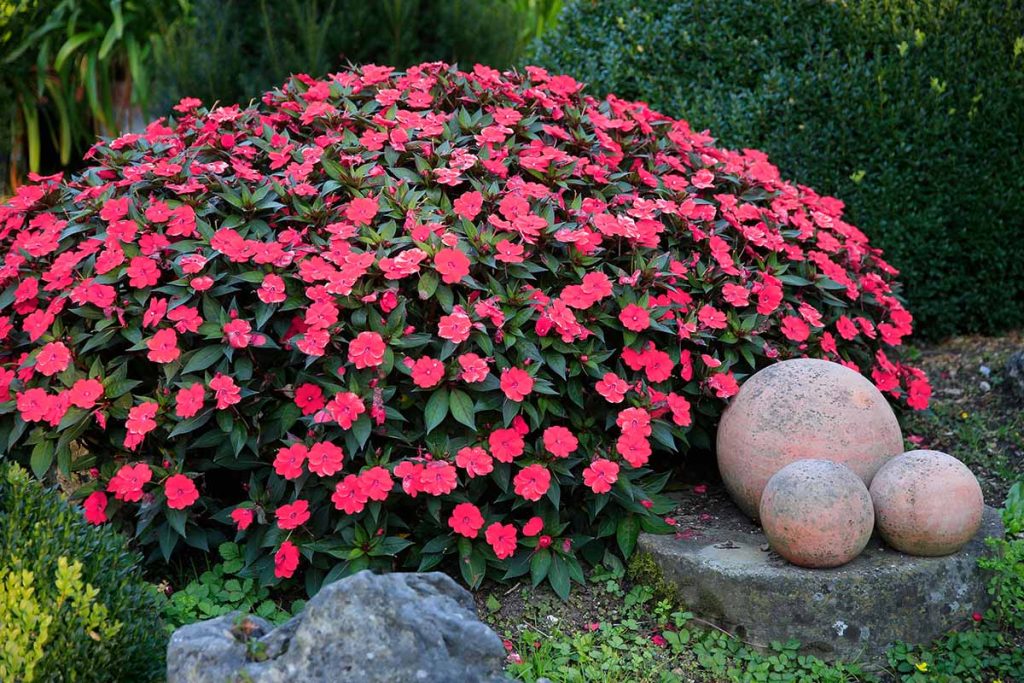
Impatiens, bright and colorful annual flowers, are excellent for adding vibrancy to shaded areas while also attracting hummingbirds.
These flowers thrive in moist, well-draining soil and prefer deep shade. Hanging them on porches can also provide a suitable growing environment.
Impatiens are typically grown from nursery-bought plants, which are densely planted together to create a lush carpet of flowers and foliage. Seeds can be collected from mature plants and sown indoors 10 weeks before the last frost, as they require a longer time to flower. Cuttings can also be taken in the fall and grown indoors until the frost has passed.
Common Name: Impatiens, jewelweed, touch-me-not, snapweed, patience
Scientific Name: Impatiens
Growing Zones: 2 – 11
Sun: Shade or partial shade
Soil: Rich, well-draining
Colors: Red, pink, purple, yellow, coral
Height: 6 – 36 inches
Spread: 1 – 3 feet
Plant Type: Annual
6. Columbine
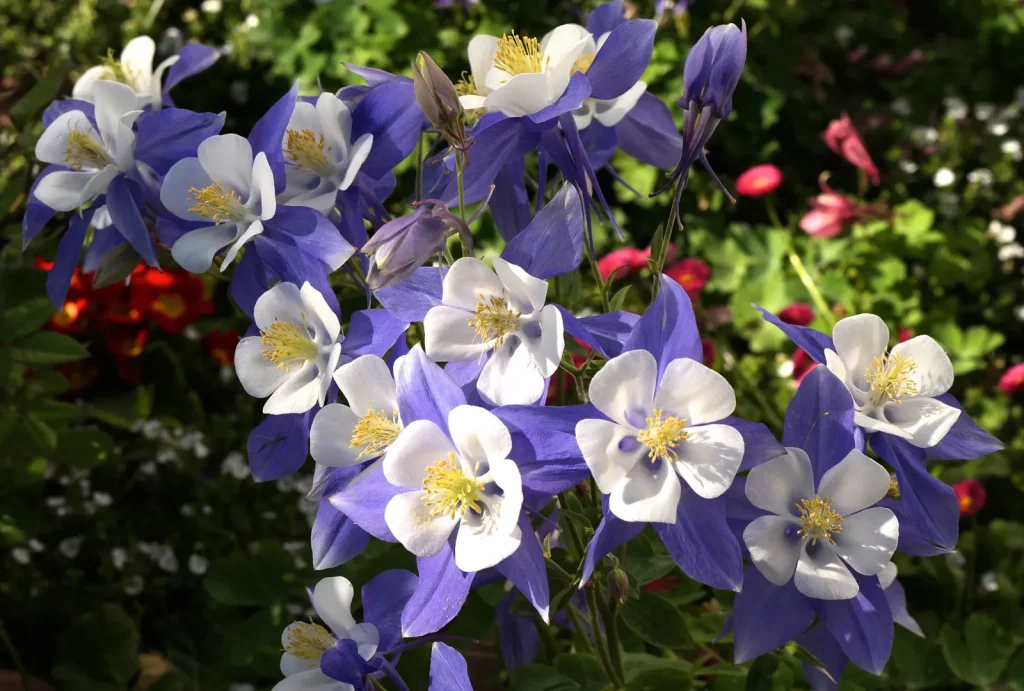
Columbines are highly recommended for attracting hummingbirds due to their range of vibrant colors and adaptability to partial shade.
Columbine, scientifically known as Aquilegia, is an elegant perennial plant with spiky, bell-shaped blooms measuring 3 to 6 inches long.
Numerous columbine varieties exist, but most thrive in partial shade to full shade and bloom as early as spring, making them an excellent choice for attracting hummingbirds.
Apart from shade tolerance, columbines are drought-tolerant and resistant to deer.
Seeds can be sown directly in the ground in spring, and self-seeding occurs if flowers are left at the end of the blooming season. For an early start, seeds can be sown indoors 6 to 8 weeks before the last frosts. Seed-grown plants may not produce flowers until their second year.
Common Name: Columbine, Aquilegia
Scientific Name: Aquilegia
Growing Zones: 3-9
Sun: Full sun to partial shade
Soil: Neutral pH, moist but not waterlogged
Colors: Red, pink, blue, orange, white, yellow
Height: 1 – 3 feet
Spread: 1 foot
Plant Type: Perennial
7. Coneflower
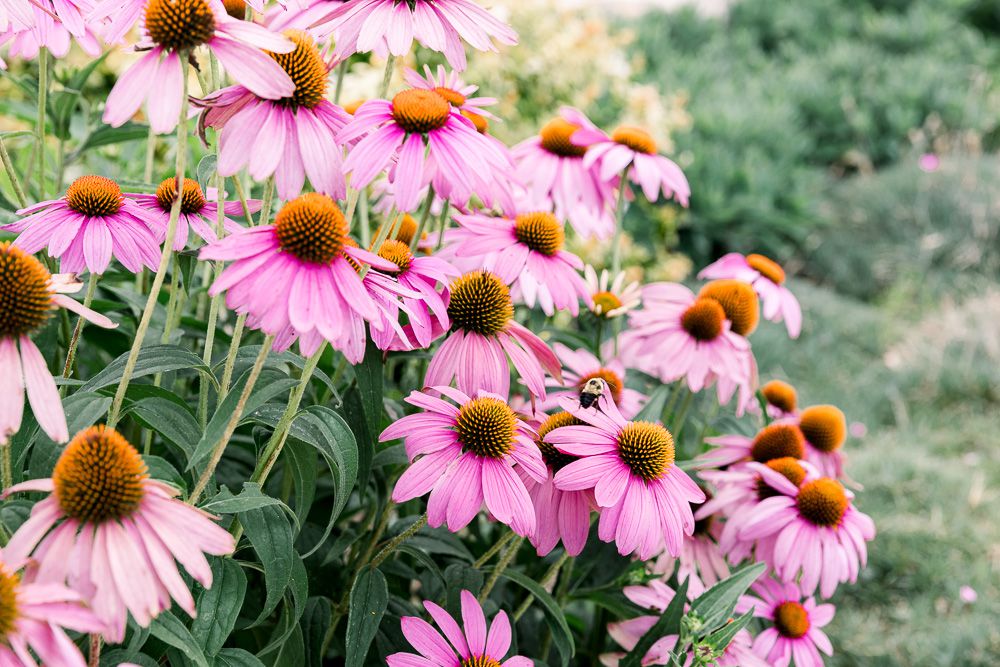
Coneflower, scientifically known as Echinacea, belongs to the daisy family, Asteraceae. The name “Echinacea” originates from Greek, meaning “sea urchin,” owing to its shiny central disk.
The term “Coneflower” refers to the downward-pointing petals of the open central flower head, resembling a cone. The most common ornamental coneflower for backyard cultivation is Echinacea purpurea, native to eastern North America.
Coneflowers are large, approximately 6 inches in diameter, with stems reaching a height of around 5 feet. The flowers come in various colors, such as pink, red, orange, yellow, and white, depending on the variety. They thrive in full sun and prefer well-draining soil. The flowers bloom abundantly from summer to fall.
The vividly colored flowers, especially reds and purples, are highly attractive to hummingbirds and other pollinators like bees and butterflies. The nectar-rich central cone serves as a delightful feast for hummingbirds.
Common Name: Coneflower
Scientific Name: Echinacea
Growing Zones: 3 – 9
Sun: Full sun
Soil: Varies
Colors: White, yellow, orange, pink, red, purple, green
Height: 2 to 5 feet tall
Spread: 1½ – 2 feet wide
Plant Type: Perennial
8. Penstemon
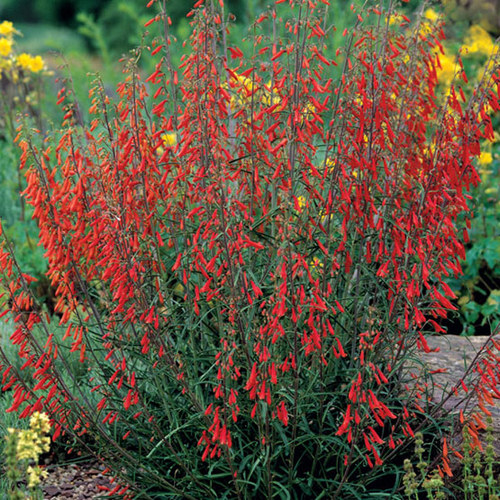
Penstemon, a genus in the plantain family (Plantaginaceae), comprises over 250 ornamental flowering plants, including snapdragons and foxgloves. It is also referred to as Beardtongue due to the tuft of small hairs on the pollen-free stamen that resembles a beard.
With numerous species and varieties available, Penstemon offers a wide range of options to suit different backyard settings. They are drought-tolerant, attract hummingbirds and bees, easy to care for, and their beautiful blooms add color to any garden.
Penstemon flowers bloom in early summer, displaying spires and clusters of tubular flowers in various colors. Varieties include blue, purple, red, orange, white, pink, and yellow.
Hummingbirds are drawn to Penstemon because of their vibrant colors and nectar-rich blooms.
Plant Penstemon in areas that receive full sunlight, as this promotes abundant flowering and upright stem growth. They prefer nutrient-poor soil with moist conditions. While they can tolerate drought, occasional watering is beneficial. Choosing a variety suited to your specific soil and climate conditions can ensure their longevity.
Common Name: Penstemon, foxglove beard-tongue, talus slope penstemon, white beardtongue
Scientific Name: Penstemon
Growing Zones: 3 – 9
Sun: Full sun
Soil: Lean, fast-draining
Colors: Blue, purple, red, orange, white, pink, yellow
Height: 6 to 12 inches, 1 to 3 feet, 3 to 8 feet
Spread: 8 to 20 inches
Plant Type: Perennial
9. Summersweet
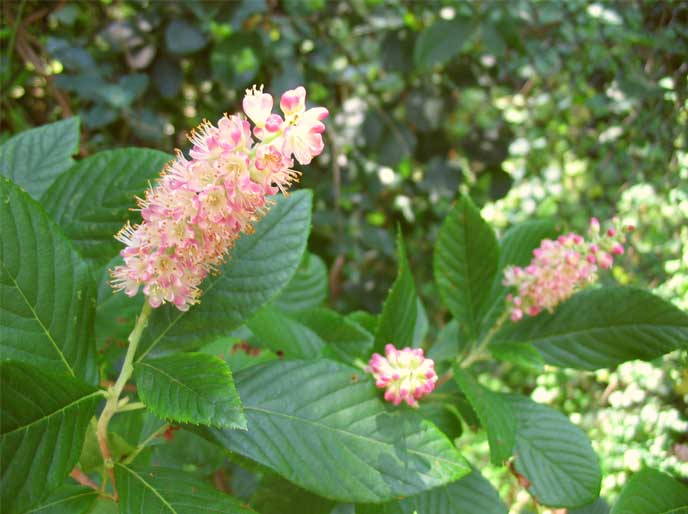
Summersweet is a flowering shrub that not only enhances the aesthetics of your backyard but also attracts hummingbirds.
Scientifically known as Clethra alnifolia, Summersweet is a flowering plant belonging to the Clethraceae family. It is native to eastern North America and thrives in various climates, particularly wetlands and the edges of ponds and streams.
Summersweet features vertical spikes of fragrant white flowers against dark green foliage. During autumn, its green leaves transition to yellow or gold. The name “pepperbush” comes from the brown seed capsules resembling peppercorns that are shed after blooming.
Summersweet flowers bloom between July and August, measuring 2 to 6 inches long in white or pink shades. The fragrance emitted by these flowers is irresistible to butterflies, hummingbirds, and other pollinators. During autumn, the pepper-like seeds attract birds.
Due to their coastal origins, Summersweet thrives in moist to wet soil and shade. Shade exposure results in larger blooms compared to excessive sunlight. Adequate hydration is crucial during dry weather. Additionally, Summersweet can tolerate salty air, making it suitable for coastal regions.
To care for Summersweet, provide ample space for its spreading growth habit. Maintain soil moisture and prune old branches during spring to stimulate new growth and maintain the desired shape.
Common Name: Summersweet, coastal sweet pepperbush
Scientific Name: Clethra alnifolia
Growing Zones: 3 – 9
Sun: Full sun or partial shade
Soil: Moist to wet, slightly acidic
Colors: White, pink, rose-colored
Height: 4 – 8 feet tall
Spread: 4 – 6 feet wide
Plant Type: Perennial, deciduous shrub
10. Yarrow
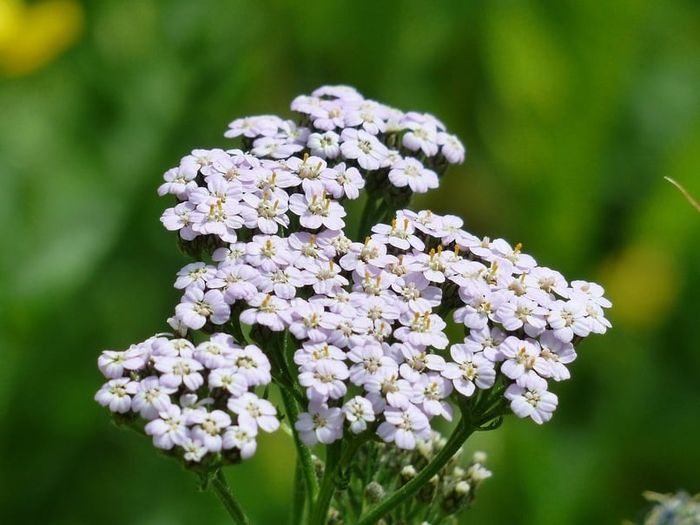
Yarrow, scientifically known as Achillea millefolium, holds significant folklore associated with its name. The name “Achillea
” stems from the legendary Greek hero Achilles, who reputedly used yarrow to treat wounds suffered by his soldiers.
Yarrow is also called “Nosebleed” due to its historical usage in stopping or initiating nosebleeds. The term “millefolium” translates to “thousand leaves,” referring to its feather-like foliage, which appears divided into numerous leaflets.
Common Yarrow is widely grown in backyards for its clusters of tiny flowers, available in white, yellow, pink, or red, depending on the variety. These clusters contain 15 to 40 flowers tightly packed on their stems.
The feathery leaves of Yarrow are visually appealing, evenly distributed along the stems and measuring 2 to 8 inches in length. The lower and middle leaves tend to grow larger. Yarrow leaves have a fern-like appearance and emit a pleasant fragrance.
In addition to attracting hummingbirds, bees, and butterflies, Common Yarrow serves various medicinal purposes, such as wound and burn treatment, alleviating colds, fevers, and headaches.
Common Name: Common Yarrow, Milfoil, Nosebleed, Thousand-leaf
Scientific Name: Achillea millefolium
Growing Zones: 3 – 9
Sun: Full sun
Soil: Sandy, loamy, clay, well-draining
Colors: White, yellow, pink, red
Height: 2 to 3 feet tall
Spread: 2 to 3 feet wide
Plant Type: Perennial
11. Butterfly Weed
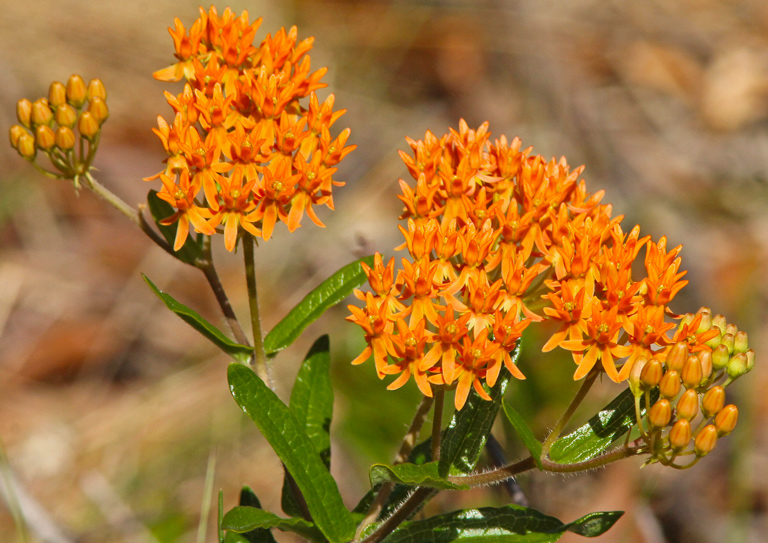
Butterfly Weed, scientifically known as Asclepias tuberosa, is a vibrant and captivating plant that captivates attention with its showy appearance. It derives its common name, Pleurisy Root, from the historical usage by Native Americans, who chewed its robust root as a medicinal remedy for pleurisy and other respiratory ailments. Despite its name, Butterfly Weed also goes by Orange Milkweed due to its orange-hued flowers and membership in the Milkweed family, though it lacks the milky sap commonly associated with this family.
If you desire to create an inviting haven for butterflies, bees, and hummingbirds in your garden, introducing Butterfly Weed is a must. Its clusters of orange to yellow flowers, brimming with nectar, emerge atop thick and hairy stems amidst lush, bright green foliage.
The blossoms grace the garden from late spring through summer, but be mindful of removing the seed pods if you wish to prevent self-seeding, as they can become invasive.
While Butterfly Weed plants are relatively easy to cultivate, they require patience as it may take up to three years before they produce their enchanting blooms. For optimal growth, it is recommended to plant them in a permanent location, as their tuberous roots prefer stability. Flourishing under full sunlight, they demand minimal watering once established.
Planting Butterfly Weed not only enhances the beauty of your garden and provides nourishment to hummingbirds, bees, and butterflies but also aids in the preservation of monarch butterflies, which rely on milkweed leaves as a crucial food source for their caterpillars.
Common Name: Butterfly Flower, Pleurisy Root, Orange Milkweed
Scientific Name: Asclepias tuberosa
Growing Zones: 3 – 9
Sun: Full sun
Soil: Poor, well-drained soil
Colors: Orange, yellow, red
Height: 1 to 2 feet tall
Spread: 12 to 18 inches wide
Plant Type: Perennial
12. Hydrangea
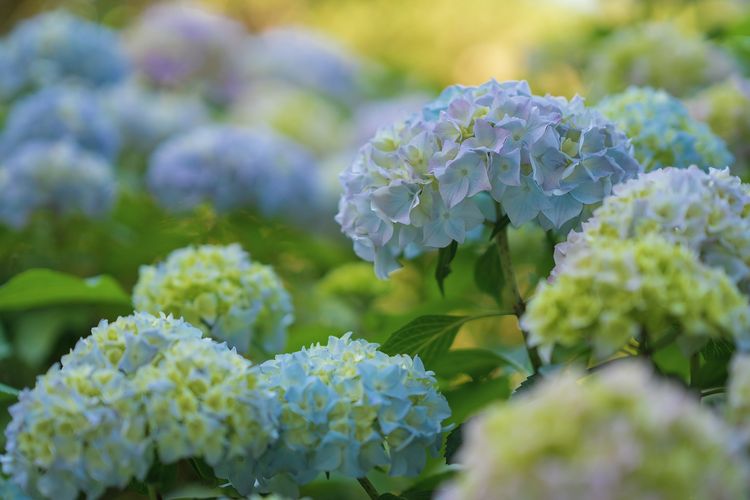
In shady areas of your yard, the grandeur of Hydrangeas’ colossal flower heads thrives. These magnificent plants prefer a cooler environment and therefore appreciate the shelter of shade, particularly during the afternoon hours.
Moist soil is also a preference for Hydrangeas, necessitating generous watering at least once a week, especially during dry conditions. Pruning is recommended after the flowers have withered in the winter season.
Hydrangea flowers continue to adorn the landscape from spring until the peak of autumn, contributing interest even during the winter months.
Common Name: Hydrangea
Scientific Name: Hydrangea
Growing Zones: 3 – 9
Sun: Full sun to shade
Soil: Fertile, well-draining
Colors: Pink, red, white, blue, green
Height: 3 – 15 feet
Spread: 2 – 12 feet
Plant Type: Perennial
13. Veronica
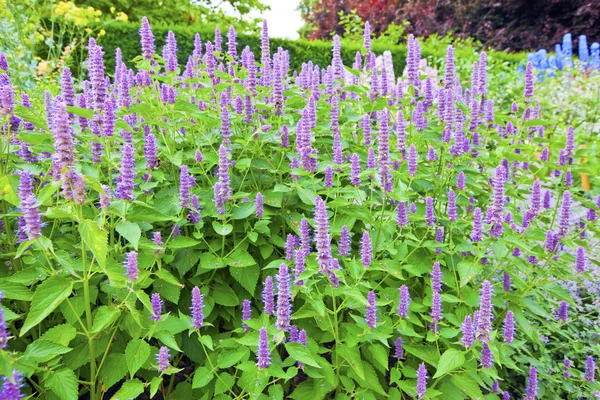
Veronica encompasses a vast genus of flowering plants, boasting an impressive array of approximately 500 species. This abundance renders it the largest genus within the Plantaginaceae family. These herbaceous plants are classified as either perennials or annuals and are native to temperate regions of the Northern Hemisphere.
Veronica presents numerous varieties, with some low-growing species perfect for ground covers that bloom in the spring, while others grow tall with upright flower spikes that grace the landscape during summer.
Among the notable Veronica species is Veronica spicata, renowned for its vibrant vertical spikes of flowers. Adorned with clumps of tiny flowers in hues of white, pink, purple, and blue, these spikes hold great appeal for hummingbirds, butterflies, and bees.
Endowed with hardstems and attractive foliage, Veronicas are relatively low-maintenance plants that can thrive in a variety of soil types. They prefer well-drained soil and moderate watering. They also tolerate full sun to partial shade, depending on the species.
Veronicas are known for their long-lasting blooms and can add a splash of color to your garden throughout the summer months. They make excellent border plants, container plants, or additions to rock gardens. Some popular Veronica species include Veronicastrum virginicum (Culver’s Root), Veronica spicata (Spike Speedwell), and Veronica umbrosa (Woodland Speedwell).
Common Name: Veronica, Speedwell
Scientific Name: Veronica
Growing Zones: Varies depending on species
Sun: Full sun to partial shade
Soil: Well-drained soil
Colors: White, pink, purple, blue
Height: Varies depending on species
Spread: Varies depending on species
Plant Type: Perennial or annual
14. Black-Eyed Susan
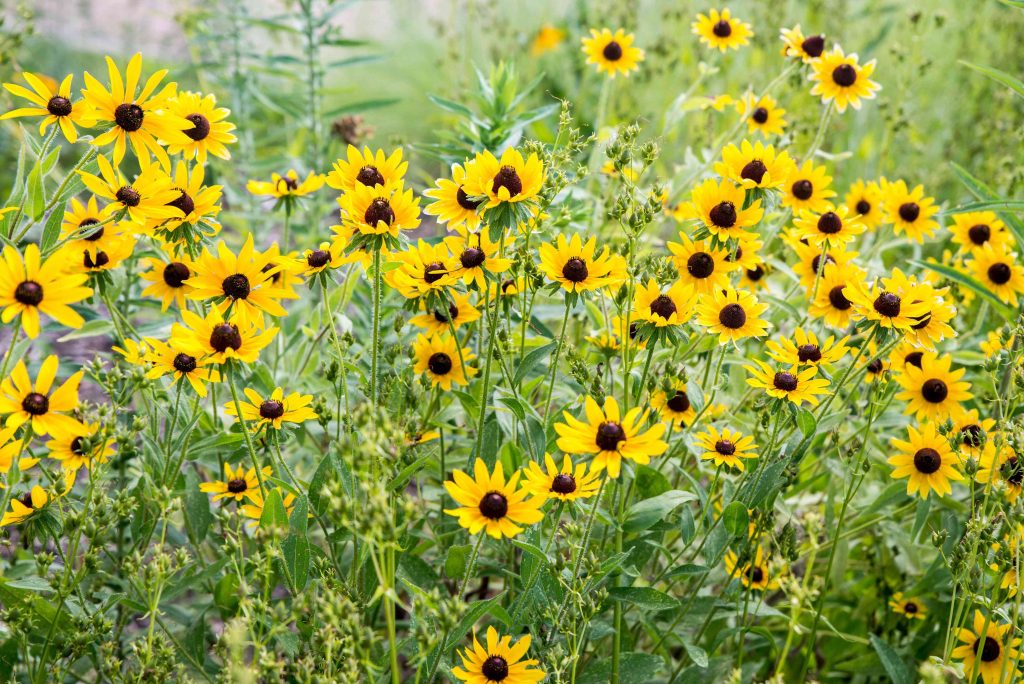
Black-Eyed Susan, scientifically known as Rudbeckia hirta, is a cheerful and vibrant perennial flower that adds a burst of color to any garden. It is native to North America and is named for its distinct dark brown center, surrounded by bright yellow or orange petals. The contrasting colors create a stunning visual display and make Black-Eyed Susan a popular choice for gardens and landscapes.
These hardy plants are easy to grow and require minimal maintenance. They thrive in full sun to partial shade and prefer well-drained soil. Black-Eyed Susan blooms from mid-summer to early fall and attracts butterflies and bees with its nectar-rich flowers.
Black-Eyed Susan plants can reach a height of 2 to 3 feet and have a spread of 1 to 2 feet. They make excellent cut flowers and can be used in bouquets or floral arrangements.
Common Name: Black-Eyed Susan
Scientific Name: Rudbeckia hirta
Growing Zones: 3 – 9
Sun: Full sun to partial shade
Soil: Well-drained soil
Colors: Yellow, orange
Height: 2 – 3 feet
Spread: 1 – 2 feet
Plant Type: Perennial
15. Coneflower
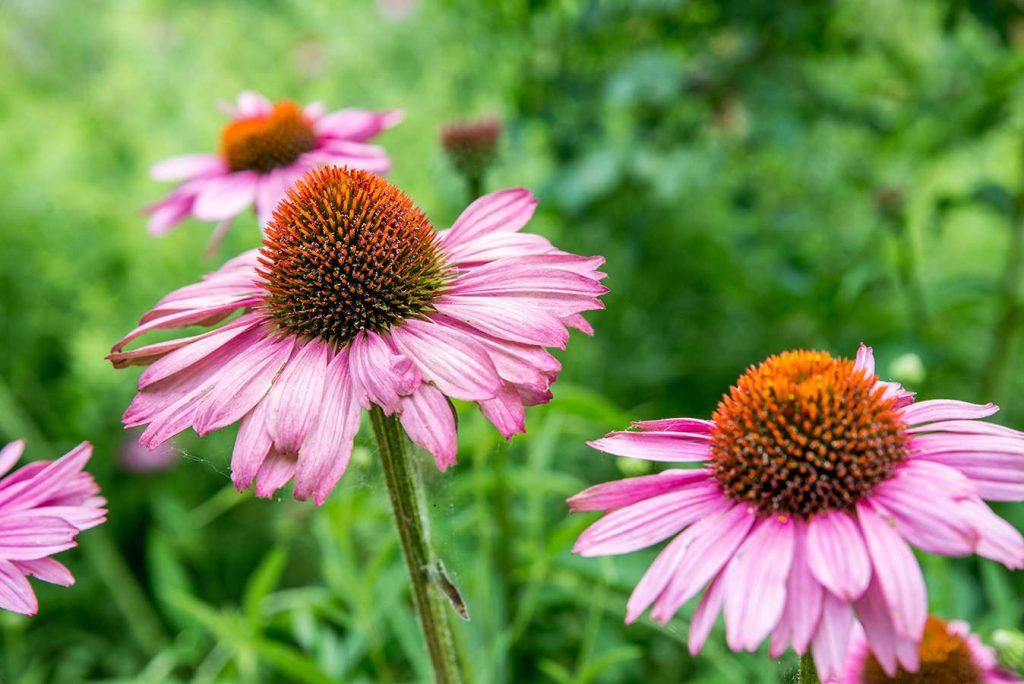
Coneflower, also known as Echinacea, is a popular perennial flower native to North America. It is named for its distinctive cone-shaped center, surrounded by petals in shades of pink, purple, white, or orange. Coneflowers are not only beautiful but also have medicinal properties and are often used in herbal remedies.
These hardy plants are drought-tolerant and can withstand a variety of soil conditions, making them suitable for a wide range of gardens. They prefer full sun but can tolerate partial shade. Coneflowers bloom from early summer to fall and attract butterflies, bees, and birds with their nectar-rich flowers and seed heads.
Coneflower plants can reach a height of 2 to 4 feet and have a spread of 1 to 2 feet. They are low-maintenance and require minimal watering once established.
Common Name: Coneflower, Echinacea
Scientific Name: Echinacea
Growing Zones: 3 – 9
Sun: Full sun to partial shade
Soil: Well-drained soil
Colors: Pink, purple, white, orange
Height: 2 – 4 feet
Spread: 1 – 2 feet
Plant Type: Perennial
These are just a few examples of beautiful flowering plants that can add color and charm to your garden. Depending on your location and personal preferences, there are countless other options to explore. Happy gardening!
16. Daylily
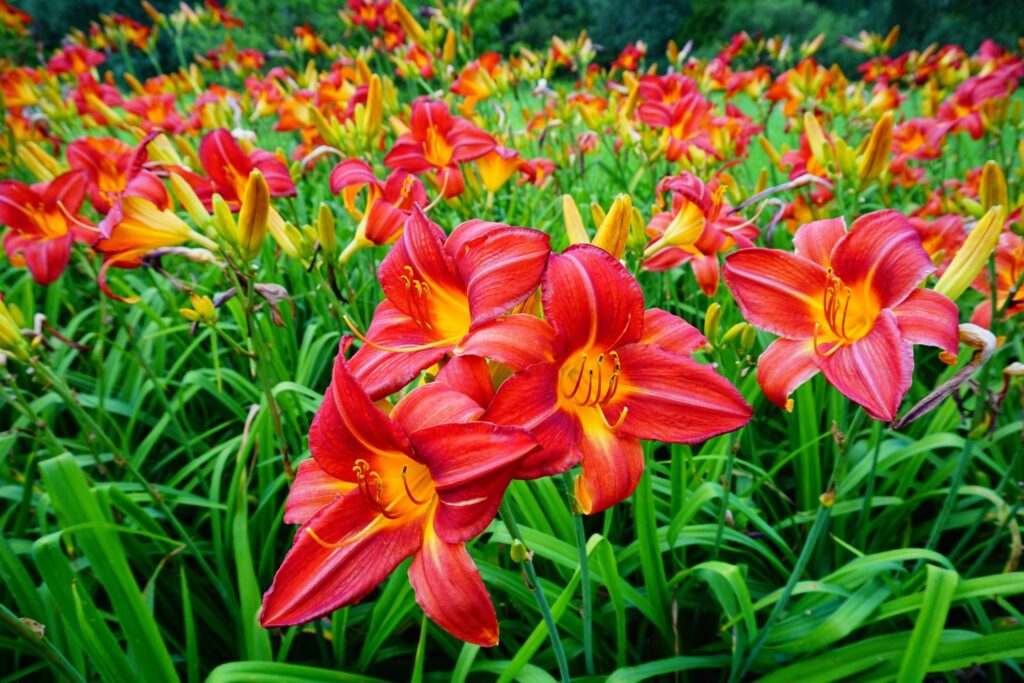
Daylilies, scientifically known as Hemerocallis, are versatile and hardy perennial flowers that come in a wide range of colors, shapes, and sizes. They are called “daylilies” because each flower typically lasts for only a day, but they produce multiple flowers on each stalk, resulting in a continuous display throughout their blooming season.
Daylilies are easy to grow and require minimal care. They are adaptable to various soil types and can tolerate both sun and partial shade, although they tend to bloom more prolifically in full sun. Daylilies come in a variety of colors, including shades of yellow, orange, red, pink, and purple. Some varieties even exhibit bi-color or patterned petals.
These perennials are known for their clumping growth habit, with each clump producing numerous flower stalks. Daylilies can range in height from 1 to 4 feet, depending on the variety. They make excellent border plants, ground covers, or focal points in garden beds.
Common Name: Daylily
Scientific Name: Hemerocallis
Growing Zones: 3 – 9 (varies by species)
Sun: Full sun to partial shade
Soil: Well-drained soil
Colors: Various (yellow, orange, red, pink, purple, etc.)
Height: 1 – 4 feet (varies by species)
Spread: Varies by species
Plant Type: Perennial
17. Marigold
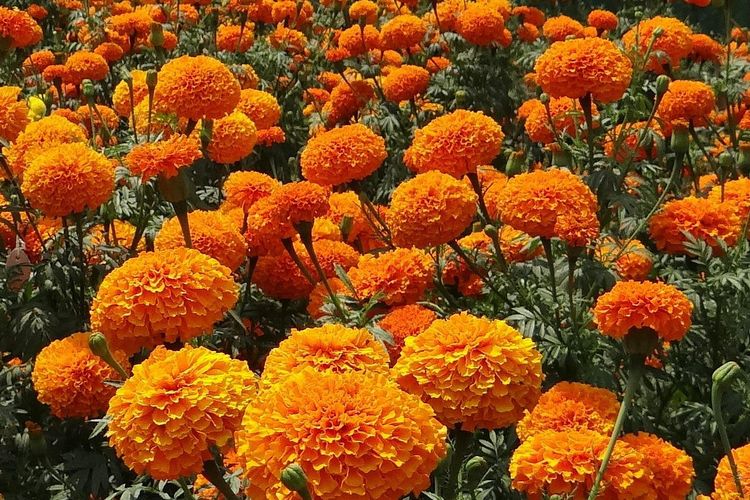
Marigolds, scientifically known as Tagetes, are vibrant annual flowers that are widely cultivated for their bright and cheerful blooms. They are native to the Americas and have become popular garden plants worldwide due to their easy cultivation and pest-repellent properties.
Marigolds feature clusters of daisy-like flowers in shades of yellow, orange, and red. They bloom continuously throughout the summer and fall, attracting bees and butterflies to their nectar-rich flowers. Marigolds also have a distinctive scent that repels certain garden pests, making them a useful companion plant in vegetable gardens.
These sun-loving plants prefer well-drained soil and require moderate watering. Marigolds are versatile and can be grown in garden beds, containers, or as edging plants. Their compact growth habit ranges from 6 inches to 3 feet in height, depending on the variety.
Common Name: Marigold
Scientific Name: Tagetes
Growing Zones: 2 – 11 (varies by species)
Sun: Full sun
Soil: Well-drained soil
Colors: Yellow, orange, red
Height: 6 inches – 3 feet (varies by species)
Spread: Varies by species
Plant Type: Annual
18. Petunia
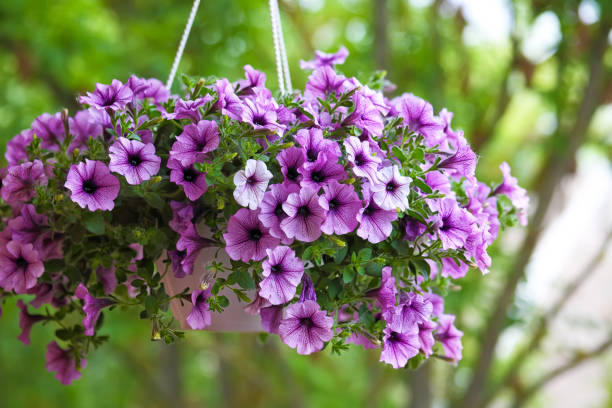
Petunias are popular annual flowers that are cherished for their abundant blooms and wide range of vibrant colors. They belong to the Solanaceae family and are native to South America. Petunias are widely cultivated and available in various forms, including grandiflora, multiflora, and spreading varieties.
These sun-loving plants are excellent choices for adding splashes of color to garden beds, hanging baskets, or containers. Petunias come in almost every color imaginable, including shades of pink, purple, red, white, and bi-color combinations. Some varieties also have attractive veining or contrasting throat markings.
Petunias prefer well-drained soil and require regular watering, especially during hot and dry periods. Deadheading spent flowers can encourage continuous blooming. The height and spread of petunias depend on the variety, with trailing or spreading types cascading over edges and compact forms staying more upright.
Common Name: Petunia
Scientific Name: Petunia
Growing Zones: Annual (can be grown as a
perennial in frost-free areas)
Sun: Full sun to partial shade
Soil: Well-drained soil
Colors: Various (pink, purple, red, white, etc.)
Height: Varies by variety
Spread: Varies by variety
Plant Type: Annual (some perennial varieties available)
These are just a few more examples of stunning flowering plants that can enhance the beauty of your garden. Remember to consider your local climate and growing conditions when selecting flowers for your specific location. Enjoy creating a colorful and vibrant garden!
19. Geranium

Geraniums, scientifically known as Pelargonium, are popular flowering plants that are valued for their vibrant flowers and aromatic foliage. They are native to South Africa and are widely cultivated as garden plants around the world.
Geraniums come in a variety of species and cultivars, offering a range of flower colors, including shades of red, pink, purple, and white. The flowers are typically five-petaled and have a symmetrical shape. Geraniums bloom profusely during the summer and early fall, attracting bees and butterflies to their nectar-rich blooms.
These versatile plants can be grown in garden beds, containers, hanging baskets, or as border plants. Geraniums thrive in well-drained soil and prefer full sun to partial shade. They are relatively low-maintenance and require regular watering, allowing the soil to dry slightly between waterings.
Common Name: Geranium
Scientific Name: Pelargonium
Growing Zones: 9 – 11 (can vary by species)
Sun: Full sun to partial shade
Soil: Well-drained soil
Colors: Various (red, pink, purple, white, etc.)
Height: Varies by species and cultivar
Spread: Varies by species and cultivar
Plant Type: Annual or perennial (depending on the species)
20. Salvia
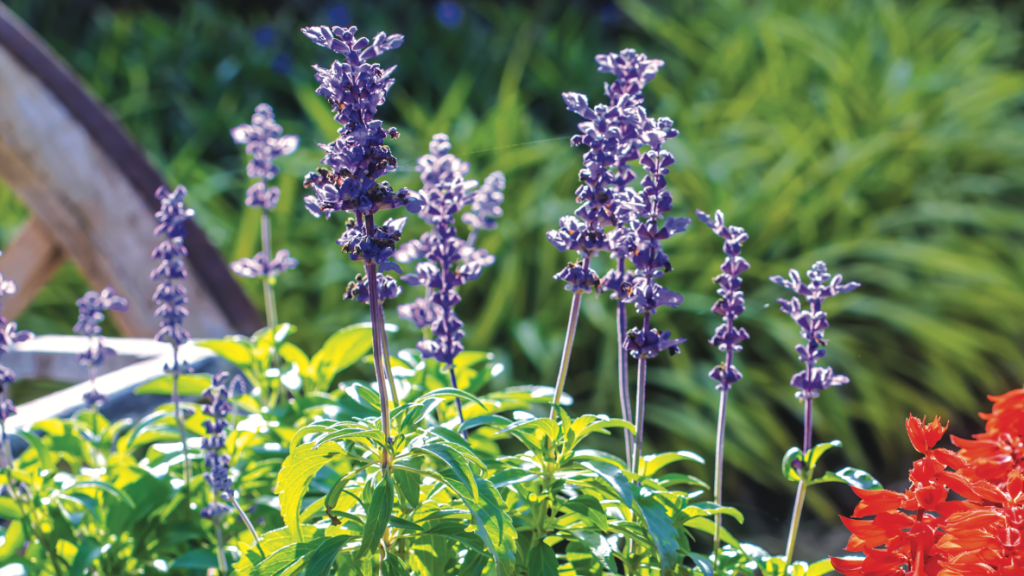
Salvias, commonly known as sage, are a diverse group of flowering plants that belong to the Lamiaceae family. They are native to various regions around the world and are valued for their attractive flowers, aromatic foliage, and pollinator-attracting properties.
Salvias are known for their spiky clusters of tubular flowers, which come in a range of colors such as blue, purple, red, pink, and white. The flowers are often rich in nectar, making them highly attractive to hummingbirds, bees, and butterflies. In addition to their ornamental value, salvias are also used for culinary and medicinal purposes.
These plants prefer well-drained soil and thrive in full sun to partial shade. Salvias are generally low-maintenance and drought-tolerant once established. Depending on the species, salvias can be annuals, perennials, or even shrubs, with varying heights and growth habits.
Common Name: Salvia
Scientific Name: Salvia
Growing Zones: Varies by species (typically 4 – 11)
Sun: Full sun to partial shade
Soil: Well-drained soil
Colors: Various (blue, purple, red, pink, white, etc.)
Height: Varies by species
Spread: Varies by species
Plant Type: Annual, perennial, or shrub (depending on the species)
These are two more beautiful flowering plants that can add color and interest to your garden. With their attractive blooms and various growth habits, geraniums and salvias are excellent choices for both beginner and experienced gardeners. Enjoy the process of selecting and cultivating these lovely plants!
21. Bee Balm
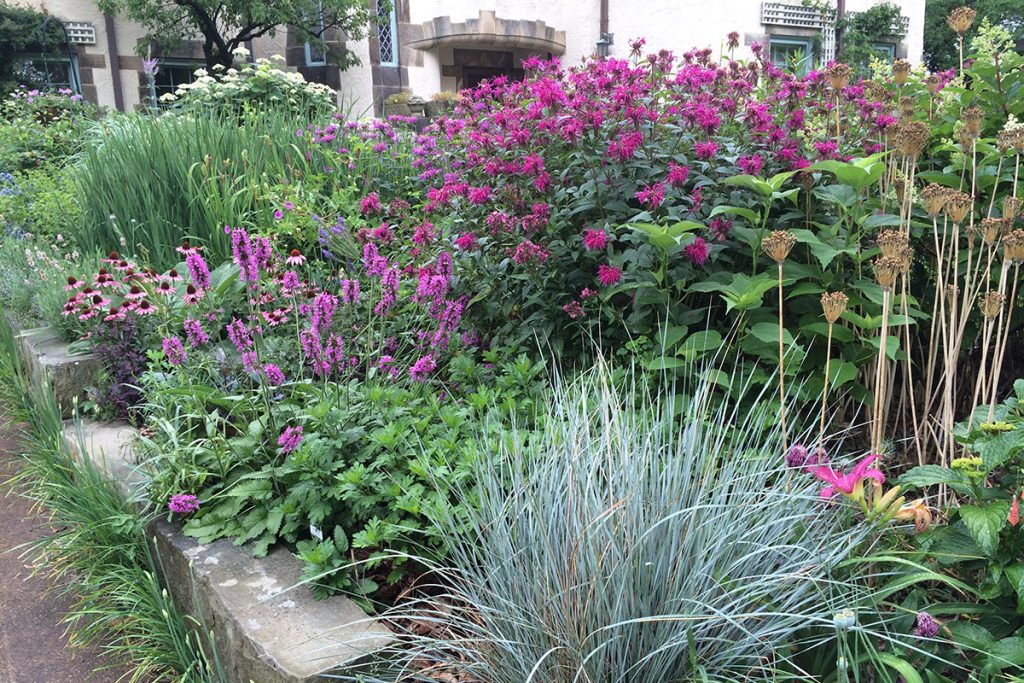
Bee Balm, a member of the Monarda mint family known as Lamiaceae, derives its name from Native Americans who used it to treat bee stings. It was also used by the Oswego Native Americans to make tea from its leaves, hence the name “Oswego Tea.”
Monarda plants not only have aromatic minty leaves but also boast striking, exotic-looking flowers that act as irresistible magnets for hummingbirds. Hummingbirds especially favor the scarlet-red flowers of Monarda didyma, which are tubular and bloom from mid-summer to early fall.
To thrive, Bee Balm requires full sun, although it can tolerate partial shade during excessively hot weather. It prefers moist, well-draining soil, so regular watering may be necessary depending on the climate.
Planting Bee Balm in your backyard offers numerous benefits. The fragrant leaves can be used in salads or brewed as tea, while the brilliant, long-blooming flowers add visual appeal to your garden. Moreover, they attract hummingbirds and other pollinators, and the leaves can be used to create essential oils for medicinal purposes.
Common Name: Bee Balm, Bergamot, Horsemint, Oswego Tea
Scientific Name: Monarda from the mint family, Lamiaceae
Growing Zones: 4 – 9
Sun: Full sun to partial shade
Soil: Rich, moist, well-draining
Colors: White, pink, red, purple
Height: 2 – 4 feet tall
Spread: 2 – 3 feet wide
Plant Type: Perennial
22. Trumpet Honeysuckle
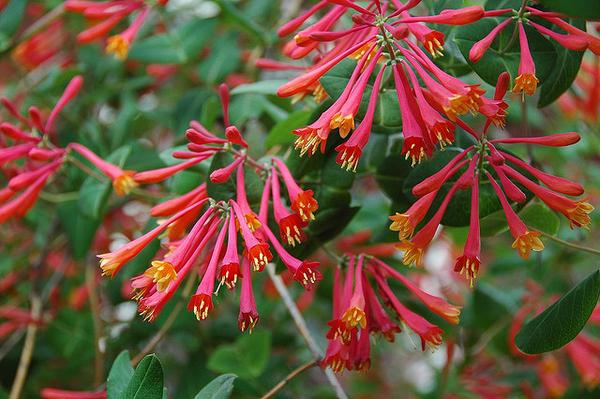
Trumpet Honeysuckle, scientifically known as Lonicera sempervirens, is a fast-growing, twining vine belonging to the Caprifoliaceae family. It is an excellent choice for adorning fences, arbors, or trellises. Alternatively, it can be allowed to crawl on the ground, making it perfect for covering concrete surfaces.
Caution should be exercised as certain honeysuckle species, like Japanese honeysuckle (Lonicera japonica), can be invasive. Therefore, it is advisable to stick with Trumpet Honeysuckle (Lonicera sempervirens) and ensure you are aware of invasive species in your area.
Trumpet Honeysuckle is particularly beloved by hummingbirds due to its bright orange-red flowers. The flowers, when opened, reveal vibrant yellow stamens. They grow in clusters of 10-20 at the ends of stems and bloom from spring to fall, creating a striking contrast against the dark green, oblong leaves.
While Trumpet Honeysuckle thrives in full sunlight, it can still grow in partial shade. However, the abundance of flowers may be reduced compared to those receiving full sun exposure.
Common Name: Trumpet Honeysuckle
Scientific Name: Lonicera sempervirens
Growing Zones: 4 – 9
Sun: Full sun, partial shade
Soil: Medium moisture, organically-rich, well-drained
Colors: Orange-red
Height: 8 – 15 feet
Spread: 3 – 6 feet
Plant Type: Semi-evergreen, deciduous, evergreen vine, perennial
23. Eastern Redbud
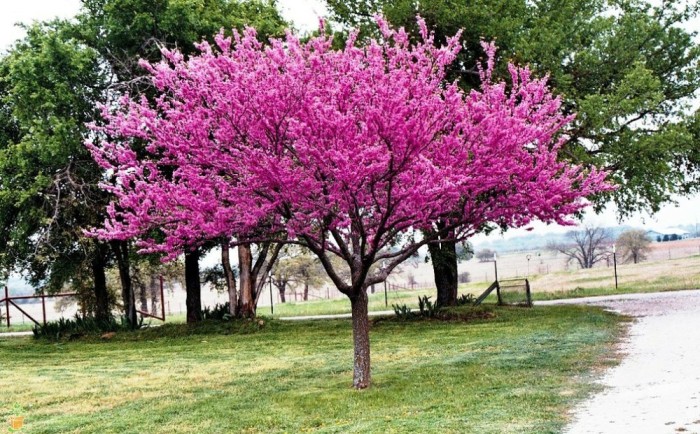
The Eastern Redbud, scientifically known as Cercis canadensis, is a large deciduous shrub or small tree native to eastern North America. It is sought after as an ornamental plant for its twisted trunk, zigzag branches, beautiful flowers, and large, heart-shaped leaves. Moreover, it is a suitable choice for small to medium-sized backyards.
What sets the Eastern Redbud apart is its unique flowering
pattern. The flowers appear before the leaves in early spring, making them the focal point of the tree during their bloom. The clusters of half-inch-wide flowers grow on the branches, with each cluster containing 4-8 flowers. The nectaries within the flowers can only be accessed by hummingbirds and long-tongued bees such as blueberry bees and carpenter bees.
The flower colors of the Eastern Redbud range from light pink to deep magenta, some even displaying a purplish tinge. Against the dark branches and trunk, the bright-colored flowers create a mesmerizing floating effect when illuminated by the right light. This stunning display lasts for approximately 2 to 3 weeks before the fruits appear.
Once the flowers have faded in mid-summer, the tree produces legume-like fruits. Initially green, these bean pods turn brown as winter approaches. The following spring, the Eastern Redbud showcases its heart-shaped leaves, initially bright green with a reddish tinge, which unfurl and expand to reveal their glossy, prominent-veined appearance.
Eastern Redbuds can tolerate both full sun and partial shade. However, to maximize their blooming potential, it is advisable to provide them with at least 6 hours of sunlight. While they can withstand periods of drought, regular watering is recommended. Pruning during the tree’s early stages helps shape and structure its growth.
Common Name: Eastern Redbud
Scientific Name: Cercis canadensis
Growing Zones: 4 – 9
Sun: Full sun, partial shade
Soil: Moist, well-drained
Colors: Pink, reddish, purple
Height: 20 to 30 feet tall
Spread: 25 to 35 feet wide
Plant Type: Perennial, deciduous tree
24. Hyacinth Bean

Hyacinth Bean, scientifically known as Lablab purpureus, is a bean vine belonging to the Fabaceae family. It goes by various names such as Indian Bean, Egyptian bean, bataw, and Australian pea. Although native to Africa, it is cultivated and used for food in Asia.
In the United States, the Hyacinth Bean is predominantly grown as an ornamental plant due to its pinkish-lavender blossoms and captivating purple seed pods. It is also referred to as the Jefferson Bean, as Bernard McMahon, Thomas Jefferson’s nurseryman, reportedly sold it to him in 1804.
For optimal flower quality, it is recommended to sow Hyacinth Bean seeds in late spring or late summer when temperatures are cooler. This allows for more abundant flowers and vigorous vine growth. Hyacinth Bean vines can reach heights of up to 25 feet when securely supported by trellises or other structures.
Flowering occurs from summer through fall, with clusters of white, pink, lavender, or purple flowers appearing along the stems. Once the flowers fade, attention shifts to the attractive seed pods. Elongated and purple in color, these pods contain 2-3 seeds each. However, it is important to note that these seeds are poisonous and should not be ingested.
Hummingbirds are particularly drawn to the vibrant purple flowers of the Hyacinth Bean. Despite their visual appeal, these plants are surprisingly low-maintenance. They thrive under full sunlight but can tolerate partial shade. Regular watering is recommended for young plants until they become established.
While the Hyacinth Bean can behave as a perennial in mild climates, treating it as an annual and saving seeds for the next season is advisable in regions with harsher conditions.
Common Name: Hyacinth Bean, Indian Bean, Egyptian bean, bataw, Australian pea
Scientific Name: Lablab purpureus
Growing Zones: 4 – 9
Sun: Full sun (no partial shade)
Soil: Well-draining
Colors: White, pink, lavender, purple
Height: 10 – 25 feet
Spread: 3 – 6 feet
Plant Type: Annual
25. Trumpet Vine
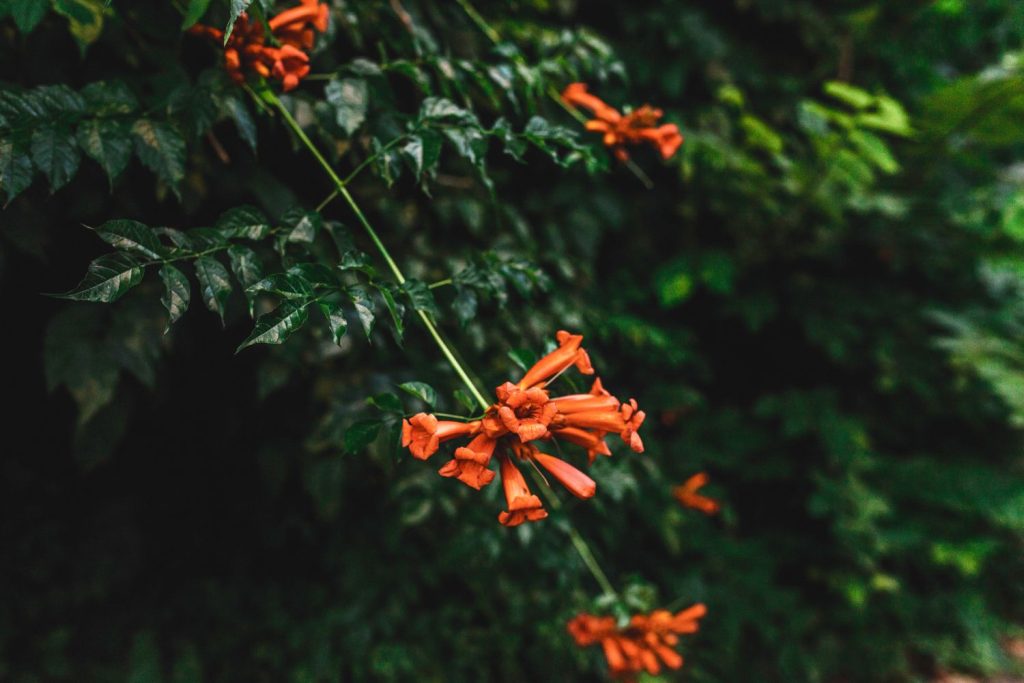
Trumpet Vine, scientifically known as Campsis radicans, belongs to the Bignoniaceae family and is native to the eastern United States. It is a fast-growing and fast-spreading species of flowering vine, capable of becoming invasive in western states if not carefully controlled through aggressive pruning. In such regions, hybrid varieties are recommended.
Also referred to as the Hummingbird Vine, it earns its name due to the irresistible allure it holds for hummingbirds when in bloom. The vibrant flowers act as a magnet, attracting hummingbirds to return repeatedly.
Some individuals also call it the Trumpet Creeper because of its ability to creep into crevices and shingles. It is valued by some for covering rock piles and tree stumps. The woody stems of the Trumpet Vine are resilient enough to withstand winter, but they can also pose a threat to foundations, fences, and trees.
Trumpet Vine is an undemanding plant that requires minimal care to thrive. It flourishes under full sunlight, producing an abundance of flowers. While it can tolerate partial shade, the number of flowers may be reduced compared to those in full sun. Regular watering is not necessary, as keeping the soil moist is sufficient.
However, regular pruning is essential to keep the Trumpet Vine in check and prevent excessive spreading. Late fall is the optimal time for pruning, allowing the plant to be cut down to almost ground level. Remarkably, it regrows quickly, especially when provided with ample sunlight.
Common Name: Trumpet Vine, Trumpet Creeper, Cow Itch
Scientific Name: Campsis radicans
Growing Zones: 4 – 9
Sun: Full sun, partial shade
Soil: Average, moist but well-drained
Colors: Orange, red, yellow
Height: 25 – 40 feet long
Spread: 5 – 10 feet wide
Plant Type: Perennial, deciduous woody vine
26. Clematis
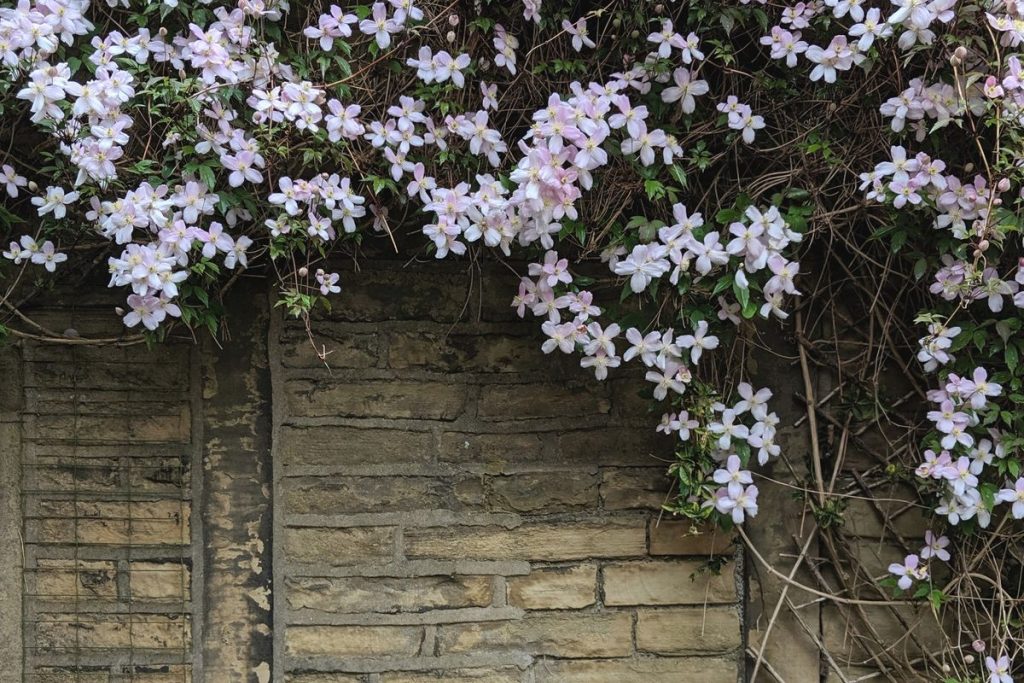
Clematis, a member of the buttercup family known scientifically as Clematis, encompasses a vast group of around 300 species of flowering vines. Originating from Japan and China, Clematis has gained popularity as an ornamental plant due to its wide array of colors, suitability for various climates, and its ability to attract hummingbirds and other pollinators to your garden.
If you’re seeking to adorn your trellis, arbor, or fence with beautiful and vibrant flowers, look no further than the Clematis vine. With its star-shaped blossoms that come in both large and small sizes, Clematis offers an extensive range of colors, including white, yellow, pink, blue, purple, and even dual-colored varieties. The blooming period varies depending on the specific variety, with some flowering in spring while others in late summer.
Apart from their captivating colors, Clematis flowers exhibit different forms. Some come in loose clusters, while others take the shape of bell-shaped or flat and open flowers. The larger flowers, spanning around 6-10 inches in diameter, are not only visually stunning but also alluring to hummingbirds and butterflies. Certain smaller Clematis varieties even boast delightful fragrances.
Clematis plants generally thrive in full sun, requiring at least six hours of direct sunlight. However, they also demand consistently moist soil to ensure gorgeous and plentiful blooms. Depending on your desired height, choose an appropriate support system for the vine, such as arbors for larger varieties or poles, fences, and trellises for smaller ones.
By providing Clematis with the ideal balance of sunlight and shade, your garden will become a haven for both the breathtaking beauty of the flowers and the enchanting presence of hummingbirds.
Common Name: Clematis, woodbine, old man’s beard
Scientific Name: Clematis
Growing Zones: 4 – 8
Sun: Full sun
Soil: Moist, well-drained
Colors: White, yellow, pink, blue, purple
Height: 2 – 5 feet, 8 – 12 feet, 20 – 30 feet
Spread: 2 – 6 feet wide
Plant Type: Perennial, woody deciduous, herbaceous, and evergreen vines
27. Foxglove
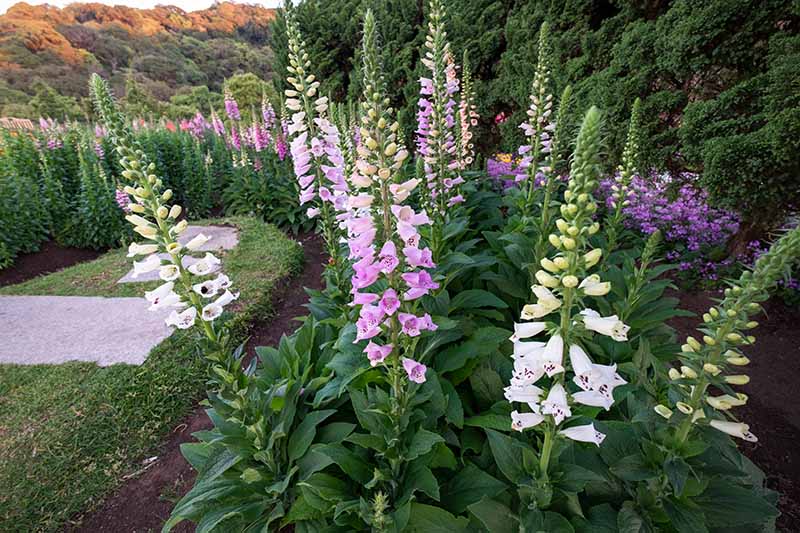
Foxglove is a stunning woodland flower characterized by its tall stems adorned with numerous bell-shaped blossoms. Flourishing in shady environments, this plant is perfectly suited for attracting hummingbirds, as their long bills and tongues can easily reach the nectar within the flowers.
Foxgloves are biennial plants, meaning they require two years to complete their life cycle. In the first year, they focus on establishing themselves without producing any flowers. It is in their second year that they showcase their glorious blooms before eventually dying off. However, fear not, as they readily self-seed, ensuring a spectacular display for many years to come.
These captivating flowers can be easily grown from seed during late spring or late summer when temperatures are cooler. Foxgloves thrive in slightly acidic, well-drained but moist soil. Their flower colors span various shades of purple, pink, and white.
With their enchanting presence and resilience in shade, Foxgloves will undoubtedly lure hummingbirds to your garden, providing a delightful spectacle for both you and these tiny avian visitors.
Common Name: Foxgloves
Scientific Name: Digitalis
Growing Zones: 4 – 8
Sun: Full sun to partial shade
Soil: Slightly acidic, well-drained but moist
Colors: Purple, pink, white
Height: 5 feet
Plant Type: Biennials
28. Lupine
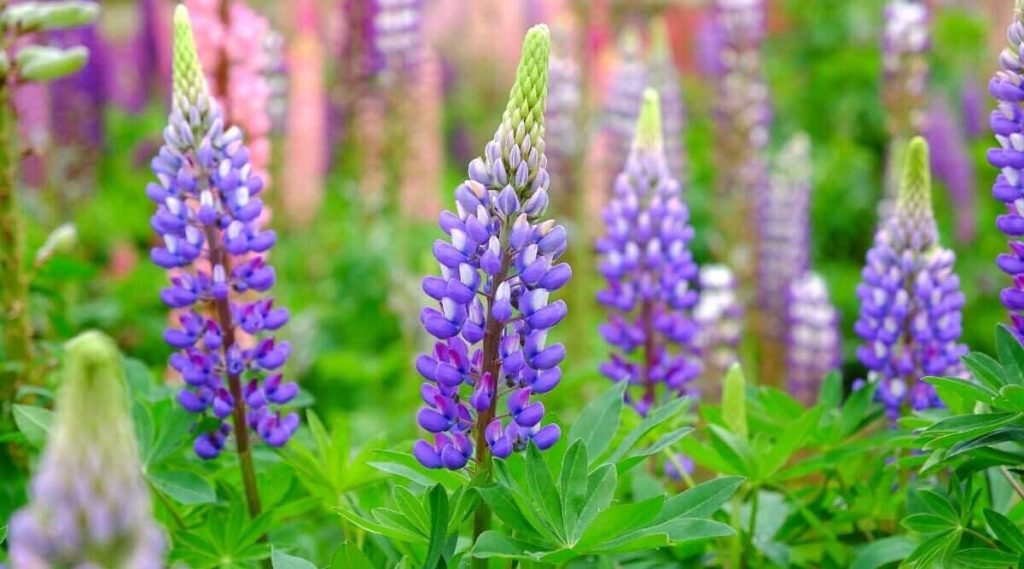
Lupine, scientifically known as Lupinus, belongs to the Fabace ae family. This flowering plant, despite possessing some toxicity that can induce allergic reactions in humans and animals, is cultivated for its ornamental value and as a food source. Native to Africa but widely grown in Asia, Lupine offers a remarkable blend of beauty and functionality.
The name “lupinus” originated from the belief that these plants voraciously consume nutrients from the soil, akin to a wolf’s appetite. In reality, Lupines are nitrogen-fixing plants, enriching the soil with this vital element. Consequently, they serve as a natural source of nitrogen for other plants in need.
With over 199 species, Lupines exhibit a remarkable diversity of flowers. The Texas bluebonnet (Lupinus texensis) is particularly renowned in the United States for its abundant blue flower spikes. Consequently, Lupine is often referred to as “bluebonnet” as well.
Notably, Lupines possess tall, vertical spikes of brightly colored flowers that effortlessly capture attention. While wild varieties primarily showcase blue and white hues, cultivated garden varieties encompass a broad spectrum, including blue, yellow, pink, red, and purple. These colorful hybrids originated from crossbreeding Lupinus polyphyllus with other variants.
Lupines’ vibrant and plentiful flowers make them irresistible to hummingbirds. Their early spring bloom coincides with a time when alternative food sources for hummingbirds are scarce, thereby attracting these delightful avian visitors to your garden.
Common Name: Lupin, lupine, bluebonnet
Scientific Name: Lupinus
Growing Zones: 4 – 8
Sun: Full sun
Soil: Rich, moist, well-drained
Colors: White, pink, red, yellow, blue, purple, bicolor
Height: 3 – 4 feet tall
Spread: 1 – 1.5 feet wide
Plant Type: Annual, perennial
29. Red Buckeye
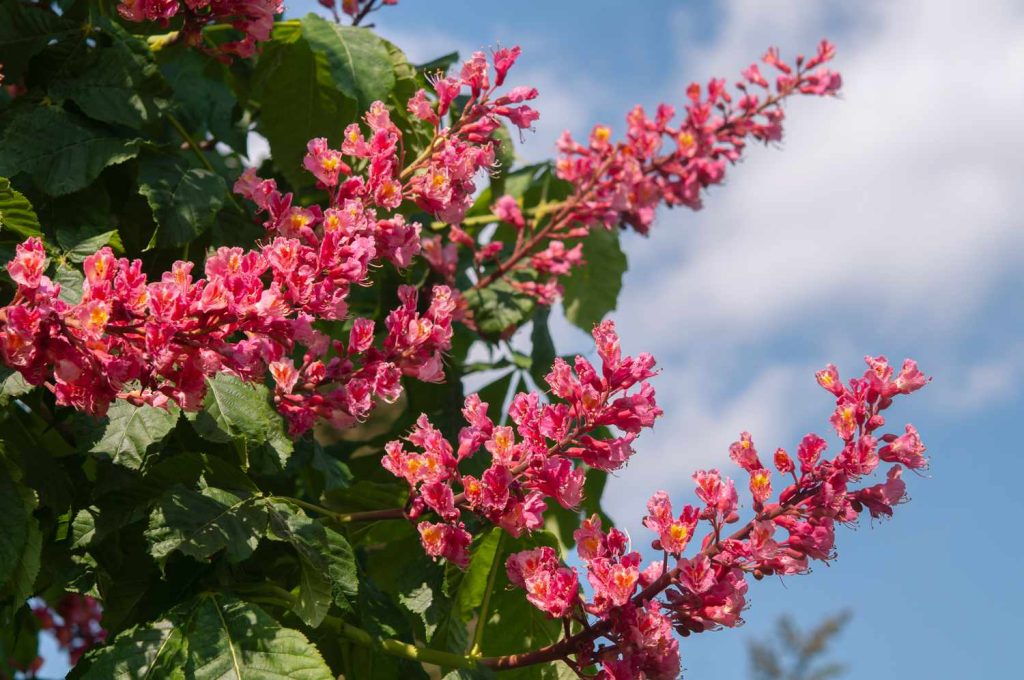
The Red Buckeye (Aesculus pavia) is a magnificent large shrub or small tree native to the Southeastern United States. Also known as Scarlet Buckeye and Firecracker plant, it offers an array of desirable features, including twisted trunks, zigzag branches, captivating flowers, and large, heart-shaped leaves. Its moderate size makes it a perfect fit for small to medium-sized backyards.
One of the most intriguing aspects of the Red Buckeye is its flowering pattern. Its blossoms appear before the leaves, adding to their visual prominence in early spring. These half-inch-wide flowers grow in clusters on the branches, typically comprising 4-8 individual blooms. Only hummingbirds and long-tongued bees, such as blueberry bees and carpenter bees, possess the means to reach the nectar within these flowers.
Red Buckeye flowers vary in color, ranging from light pink to deep magenta, with some even exhibiting a purplish tinge. Against the backdrop of dark branches and trunk, these vibrant flowers create an illusion of suspended beauty. This enchanting display lasts for approximately 2 to 3 weeks before giving way to the emergence of fruits.
In mid-summer, the flowers disappear, making way for the appearance of their fruit or legumes. Initially green, these bean-like pods gradually turn brown as winter approaches.
As winter subsides, the Red Buckeye’s leaves unfurl from winter buds, initially showcasing bright green hues with a touch of red. As they expand, they transform into heart-shaped structures with glossy, bright green surfaces and prominent veins.
While Red Buckeyes can tolerate both full sun and partial shade, providing them with approximately 6 hours of sunlight daily encourages profuse blooming. Although they exhibit some drought tolerance, regular watering is still advisable. Pruning young plants can also help shape and structure them to your liking.
Common Name: Red Buckeye
Scientific Name: Aesculus pavia
Growing Zones: 4 – 8
Sun: Full sun or partial shade
Soil: Various soil textures
Colors: Pink, reddish, purple
Height: 15 – 20 feet tall
Spread: 15 – 25 feet wide
Plant Type: Perennial, deciduous flowering tree
